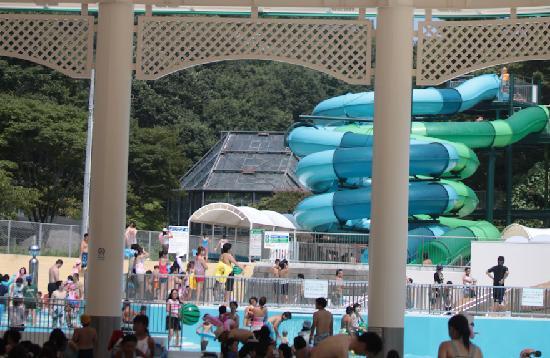Odawara Hojo Festival
Kanagawa Prefecture (神奈川県, Kanagawa-ken?) is a prefecture located in the southern Kantō region of Japan. The capital is Yokohama. Kanagawa is part of the Greater Tokyo Area.
History
The prefecture has some archaeological sites going back to the Jōmon period (around 400 BC). About 3,000 years ago, Mount Hakone produced a volcanic explosion which resulted in Lake Ashi on the western area of the prefecture.
It is believed[by whom?] that the Yamato Dynasty ruled this area from 5th century onwards. In the ancient era, its plains were very sparsely inhabited.
Kamakura in central Sagami was the capital of Japan during the Kamakura period (1185–1333).
In medieval Japan, Kanagawa was part of the provinces of Sagami and Musashi.
During the Edo period, the western part of Sagami Province was governed by the daimyo of Odawara Castle, while the eastern part was directly governed by the Tokugawa Shogunate in Edo (Tokyo).
Minato Mirai 21
Commodore Matthew Perry landed in Kanagawa in 1853 and 1854 and signed the Convention of Kanagawa to force open Japanese ports to the United States. Yokohama, the largest deep-water port in Tokyo Bay, was opened to foreign traders in 1859 after several more years of foreign pressure, and eventually developed into the largest trading port in Japan. Nearby Yokosuka, closer to the mouth of Tokyo Bay, developed as a naval port and now serves as headquarters for the U.S. 7th Fleet and the fleet operations of the Japan Maritime Self-Defense Force. After the Meiji Period, many foreigners lived in Yokohama City, and visited Hakone. The Meiji Government developed the first railways in Japan, from Shinbashi (in Tokyo) to Yokohama in 1872.
The epicenter of the Great Kantō earthquake in 1923 was deep beneath Izu Ōshima Island in Sagami Bay. It devastated Tokyo, the port city of Yokohama, surrounding prefectures of Chiba, Kanagawa, and Shizuoka, and caused widespread damage throughout the Kantō region. The sea receded as much a quarter of a mile from the shore at Manazaru Point, and then rushed back towards the shore in a great wall of water which swamped Mitsuishi-shima. At Kamakura, the total death toll from earthquake, tsunami, and fire exceeded 2,000 victims. At Odawara, ninety percent of the buildings collapsed immediately, and subsequent fires burned the rubble along with anything else left standing. p. 113].</ref>
Yokohama, Kawasaki and other major cities were heavily damaged by the U.S. bombing in 1945. Casualties amounted to more than several thousand. After the war, General Douglas MacArthur, the chief commander of Supreme Commander of the Allied Powers for the Occupation of Japan, landed in Kanagawa, before moving to other areas. U.S. military bases still remain in Kanagawa, including Camp Zama (Army), Yokosuka Naval Base, Naval Air Station Atsugi (Navy).
Prefectural office of Kanagawa
In 1945, Kanagawa was the 15th most populous prefecture in Japan, with the population of about 1.9 million. In the years after the war, the prefecture underwent rapid urbanization as a part of the Tokyo Greater Zone. The population was about 8.9 million as of 2008, and Kanagawa became the second most populous prefecture in 2006.
Transportation
Kanagawa's transport network is heavily intertwined with that of Tokyo (see: Transportation in Greater Tokyo). Shin-Yokohama and Odawara stations on the Tōkaidō Shinkansen are located in the prefecture, providing high-speed rail service to Tokyo, Nagoya, Osaka, and other major cities.
 08:23
08:23
 homesweethome
homesweethome





















 Posted in:
Posted in: 








0 意見:
Post a Comment